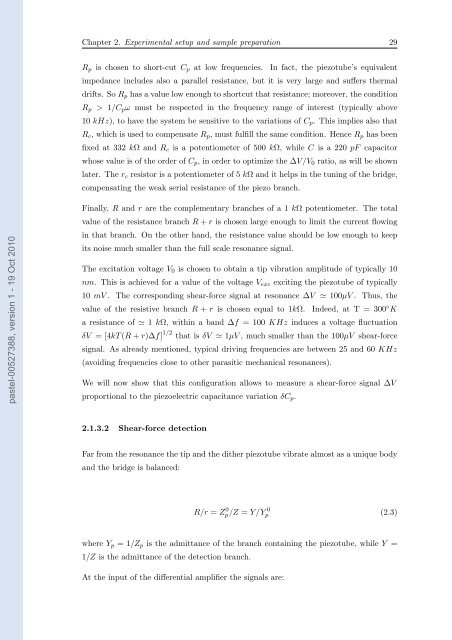Déformation photoinduite dans les films minces contenant des ...
Déformation photoinduite dans les films minces contenant des ...
Déformation photoinduite dans les films minces contenant des ...
Create successful ePaper yourself
Turn your PDF publications into a flip-book with our unique Google optimized e-Paper software.
Chapter 2. Experimental setup and sample preparation 29R p is chosen to short-cut C p at low frequencies. In fact, the piezotube’s equivalentimpedance inclu<strong>des</strong> also a parallel resistance, but it is very large and suffers thermaldrifts. So R p has a value low enough to shortcut that resistance; moreover, the conditionR p> 1/C p ω must be respected in the frequency range of interest (typically above10 kHz), to have the system be sensitive to the variations of C p . This implies also thatR c , which is used to compensate R p , must fulfill the same condition. Hence R p has beenfixed at 332 kΩ and R c is a potentiometer of 500 kΩ, while C is a 220 pF capacitorwhose value is of the order of C p , in order to optimize the ∆V/V 0 ratio, as will be shownlater. The r c resistor is a potentiometer of 5 kΩ and it helps in the tuning of the bridge,compensating the weak serial resistance of the piezo branch.pastel-00527388, version 1 - 19 Oct 2010Finally, R and r are the complementary branches of a 1 kΩ potentiometer. The totalvalue of the resistance branch R + r is chosen large enough to limit the current flowingin that branch. On the other hand, the resistance value should be low enough to keepits noise much smaller than the full scale resonance signal.The excitation voltage V 0 is chosen to obtain a tip vibration amplitude of typically 10nm. This is achieved for a value of the voltage V exc exciting the piezotube of typically10 mV . The corresponding shear-force signal at resonance ∆V ≃ 100µV . Thus, thevalue of the resistive branch R + r is chosen equal to 1kΩ. Indeed, at T = 300 ◦ Ka resistance of ≃ 1 kΩ, within a band ∆f = 100 KHz induces a voltage fluctuationδV = [4kT (R + r)∆f] 1/2 that is δV ≃ 1µV , much smaller than the 100µV shear-forcesignal. As already mentioned, typical driving frequencies are between 25 and 60 KHz(avoiding frequencies close to other parasitic mechanical resonances).We will now show that this configuration allows to measure a shear-force signal ∆Vproportional to the piezoelectric capacitance variation δC p .2.1.3.2 Shear-force detectionFar from the resonance the tip and the dither piezotube vibrate almost as a unique bodyand the bridge is balanced:R/r = Z 0 p/Z = Y/Y 0p (2.3)where Y p = 1/Z p is the admittance of the branch containing the piezotube, while Y =1/Z is the admittance of the detection branch.At the input of the differential amplifier the signals are:











![[Diffusion-Limited Aggregation - A Model for Pattern Formation].](https://img.yumpu.com/52395246/1/190x245/diffusion-limited-aggregation-a-model-for-pattern-formation.jpg?quality=85)




